Transferts monétaires et mobilité humaine
Les transferts monétaires sont souvent utilisés lors de crises afin de répondre aux besoins des personnes migrantes. Dans cette page, vous trouverez des ressources sur les transferts monétaires et la migration.

La Croix-Rouge se prépare à fournir une aide humanitaire aux migrant·es de la caravane sur le point de quitter le Honduras pour le Guatemala.
©Johannes Chinchilla / FICR.
Conflits, crises économiques et catastrophes sont autant de raisons ayant contraint des personnes à fuir et à traverser des frontières dans des conditions éprouvantes et risquées, en quête de sécurité et de moyens de subsistance. En 2020, le nombre de personnes déplacées de force s’est envolé au niveau sans précédent de plus de 80 millions de personnes, soit près du double du nombre enregistré il y a une dizaine d’année. Cette tendance s’aggrave et les effets du changement climatique menacent de déplacer jusqu’à 200 millions de personnes d’ici 2050.
L’assistance monétaire est de plus en plus utilisée afin de répondre aux besoins des personnes en situation de déplacement. On y a eu recours à grande échelle dans différents contextes de migration, en Europe en 2015 jusqu’au Venezuela pour « los caminantes ». Elle a également été utilisée dans d’autres crises migratoires, notamment en Amérique centrale, au Sahel, en Méditerranée et dans la Corne de l’Afrique. L’assistance monétaire est à l’heure actuelle l’une des principales formes d’aide apportée aux populations déplacées en Ukraine et dans les pays voisins.
Il existe une myriade de perspectives et de définitions concernant le mot « migrant·e » et la façon dont les humanitaires doivent agir. C’est pourquoi nous ne choisissons pas une définition unique pour le moment, étant donné que les discussions sur l’assistance monétaire et la migration en sont encore à leurs prémices et que le langage évolue encore.
Documenter et partager les données probantes donnera lieu à des interventions plus efficaces. Cette page contient une sélection de ressources utiles concernant la migration et le recours à l’assistance monétaire. Elle sera mise à jour au fil des discussions ayant lieu dans les espaces humanitaires des transferts monétaires.
Priorités actuelles
Afin de contribuer aux progrès relatifs à cet enjeu, nous nous engageons à :
- soutenir la création de données probantes aux niveaux régional et mondial ;
- contribuer aux solutions pratiques visant à mettre en œuvre les transferts monétaires auprès des personnes migrantes ;
- organiser des discussions sur les enjeux majeurs basées sur des données probantes.
Contenu récent

Multi-purpose Cash Assistance in Lebanon – Impact evaluation on the well-being of Syrian refugees
Report
The two year study assessed the impact of MPC on the well-being of over 11,000 Syrian refugee households living in the Bekaa, North and Mount Lebanon. The study finds that most of the impact of MPC materializes in the long term (over 12 months), while limited impact materializes in the short term. The...
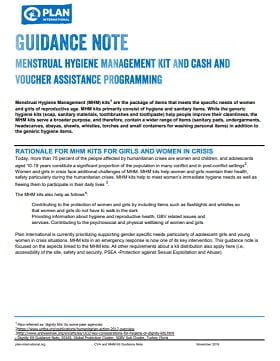
Guidance Note Menstrual Hygiene Management Kit and Cash and Voucher Assistance Programming
Guidelines and Tools
Menstrual Hygiene Management (MHM) kits are the package of items that meets the specific needs of women and girls of reproductive age. MHM kits primarily consist of hygiene and sanitary items. While the generic hygiene kits (soap, sanitary materials, toothbrushes and toothpaste) help people improve their...
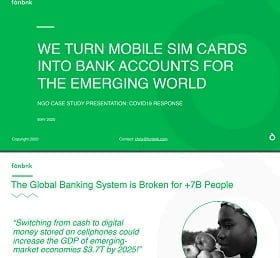
We Turn Mobile Sim Cards Into Bank Accounts for the Emerging World
Presentation
Fonbnk LLC (“Fonbnk” or the “Company”) is new distributed finance company, providing borderless banking infrastructure directly to unbanked people around the world using the mobile internet. Anyone with a prepaid mobile SIM card and a verified online identity can now have a global stored value...

The $90Bn Question: Can we reach 700 million people in response to COVID-19?
Blog Post
As COVID-19 impacts on the health, livelihoods and wellbeing of people around the world, governments and societies are faced with impossible choices. The impacts on the world’s most vulnerable are starting to bite, with an estimated 130 million additional people facing acute food insecurity by the end...

Webinar | Multi-purpose Cash Transfer and Child Protection: a case study (English and Spanish editions)
Webinar recording
Watch the webinar recording here. More information here. In 2018, with the support of OFDA and FFP, Save the Children implemented a multi-purpose cash transfer ‘Plus’ program in response to the influx of Venezuelan into Colombia. The program aimed at covering vulnerable household’s basic needs and...
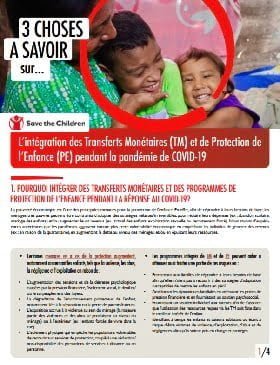
3 Choses à savoir sur…L’intégration des Transferts Monétaires (TM) et de Protection de l’Enfance (PE) pendant la pandémie de COVID-19
Guides et outils
Ce tipsheet interactif de 4 pages vise à résumer pourquoi, quels types et comment intégrer les transferts monétaires (TM) et la protection de l’enfance (PE) pendant le COVID-19. Il se concentre sur les aspects clefs liés à la conception et la mise en œuvre de programmes intégrés et propose des...

Sectoral Analysis Activities and Risk Mapping
Guidelines and Tools
This resource maps the risks, activities and impact of delivering Multi-Purpose Cash (MPC) assistance in the current COVID-19 response.

COVID-19 and Cash Transfers in MENA: What’s Possible?
Blog Post
Some of the most complex and protracted humanitarian crises in the world are in the Middle East and North Africa (MENA) region. These crises were already suffering from funding shortfalls and worsening vulnerabilities. Now, like the rest of the world, people in MENA – both host and refugee/displaced...
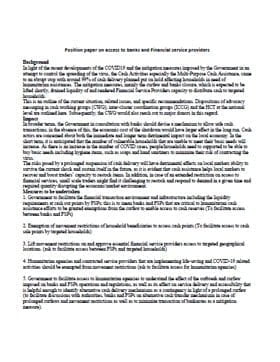
Position Paper: Humanitarian Access for CVA Delivery
Guidelines and Tools
This position paper is intended to advocate for exemptions to movement restrictions for stakeholders involved in the delivery of humanitarian cash assistance in response to COVID-19 crisis. It includes advocacy messages from cash working groups (CWG), inter-cluster coordination groups (ICCG) and the...

Case Study: Documentation of experiences using CVA for nutrition outcomes in Nigeria
Case Study
This case study was conducted as part of the wider initiative to develop guidance on the use of cash and voucher assistance (CVA) for nutrition outcomes. The case study reflects experiences and lessons learned in the context of Nigeria. It further explores opportunities to improve the nutrition...

SPACE Informal Workers and Social Protection
Guidelines and Tools
The Informal Workers and Social Protection background note outlines the options for providing social protection to informal workers, with a particular focus on the implications for COVID-19 response and urban settings. In order to do so, it provides information on the impacts of COVID-19 on earnings and...
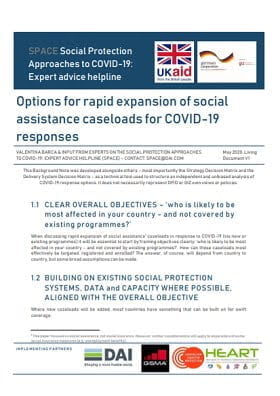
SPACE Guidance Note on Rapid Expansion of Social Protection Caseloads
Guidelines and Tools
Countries across the globe are using or adapting social protection and humanitarian cash assistance to respond to a range of immediate and medium-term impacts of COVID-19. Getting assistance to those who need it quickly is helping to safeguard the well-being of individuals and families – enabling them...
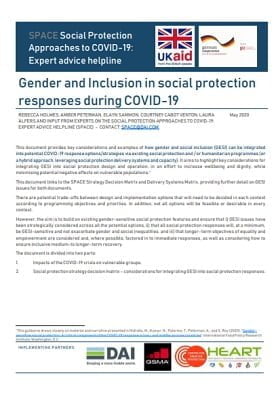
Gender and Inclusion in social protection responses during COVID-19
Guidelines and Tools
The Social Protection Approaches to COVID-19: Expert Advice Helpline (SPACE) provides donors, governments and implementing partners with direct support in thinking through how to maintain or adapt existing systems and programmes to meet rapidly growing needs. Through a multi-disciplinary...

SPACE Evaluation Delivery System Matrix
Guidelines and Tools
This Strategy Decision Matrix was developed alongside others, as a technical tool used to structure an independent and unbiased analysis of COVID-19 response options. It does not necessarily represent DFID or GIZ own views or policies. The purpose of the Evaluating Delivery Systems Matrix is to help you...

COVID-19: A chance to empower citizens through social protection
Report
Billions of US$ are now being distributed to citizens by governments to stave off deteriorating economic impact and rising poverty from COVID-19. The unprecedented pandemic demands an unprecedented government response. More than 126 countries have already introduced or adapted social protection or labour...
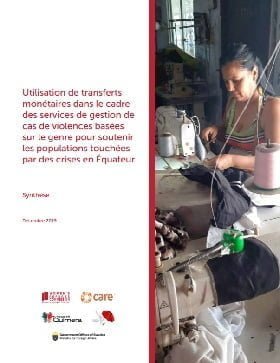
Utilisation de transferts monétaires dans le cadre des services de gestion de cas de violences basées sur le genre pour soutenir les populations touchées par des crises en Équateur
Rapport
Avec le soutien du ministère des Affaires étrangères suédois, la Commission des femmes pour les réfugiés et CARE se sont associées pour faire progresser la Feuille de route de l’appel à l’action en renforçant les capacités de prise en charge des VBG et des transferts monétaires des...

SPACE Strategy Decision Matrix
Guidelines and Tools
This strategy decision matrix was developed alongside others – most importantly the delivery system decision matrix – as a technical tool used to structure an independent and unbiased analysis of COVID-19 response options. It does not necessarily represent DFID or GIZ own views or policies. The...

Note de plaidoyer sur les impacts immédiats de la crise du COVID19 sur la sécurité alimentaire et nutritionnelle des pays d’Afrique de l’Ouest et du Centre
Rapport

Public health and social measures for Covid19 prepardness and response in low capcity and humanitarian context
Guidelines and Tools

SPACE Understanding the Economic Impacts of COVID-19 in Low- and Middle-Income Countries: Who, Where, How, and When?
Guidelines and Tools
Social protection is recognised as an essential mechanism to reach those who are in urgent need because of the COVID-19 crisis, and efforts are under way to scale up systems, so they can be ‘shock responsive’. What is needed next, however, is a much more disaggregated view, based on an understanding...